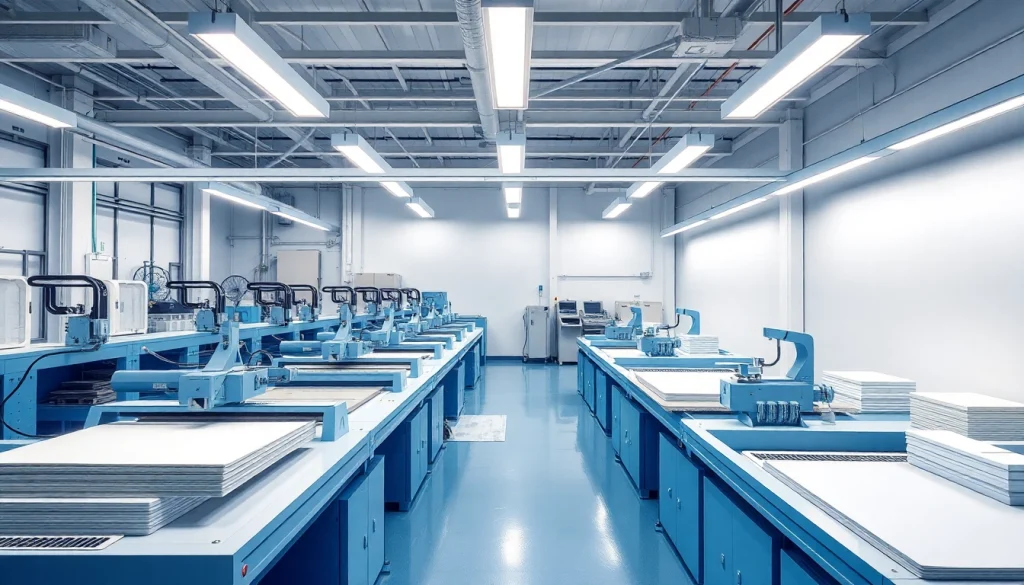Understanding Precision Die Cutting
Precision die cutting is an essential process in the manufacturing industry that allows for the creation of highly accurate and complex shapes from various materials. It involves using a sharp blade that is formed into a specific shape to cut through materials, ranging from paper and cardboard to plastic and metal. This technique has been widely adopted across multiple sectors due to its efficiency and ability to produce consistent results. For businesses looking to enhance their manufacturing capabilities, precision die cutting offers a robust solution for custom needs.
What is Precision Die Cutting?
At its core, precision die cutting is a manufacturing process that utilizes specialized tools, known as dies, to cut material into specific shapes and sizes with remarkable accuracy. The dies are designed to create clean, uniform cuts that adhere to the exact specifications provided by the client. This method is particularly favored for high-volume production because it ensures that each component maintains the same quality and dimensions, reducing waste and enhancing productivity.
Key Advantages of Precision Die Cutting
- Accuracy and Consistency: The primary advantage of precision die cutting lies in its ability to produce intricate designs with exacting tolerances. Manufacturers can achieve cuts within a few thousandths of an inch, which is vital for parts that must fit together perfectly.
- Efficiency: With the ability to rapidly produce numerous identical parts, precision die cutting significantly reduces lead times and operational costs.
- Versatility: This method can be adapted to various materials, including but not limited to plastics, metals, foams, and textiles, making it applicable across diverse industries.
- Complex Shapes: Precision die cutting enables the creation of complex geometries and custom designs that may be difficult to achieve with other cutting methods.
- Minimal Waste: By using the material in the best possible way, this process minimizes scrap and enhances sustainability in manufacturing.
Common Applications in Various Industries
Precision die cutting is employed across a wide array of industries, each utilizing its unique benefits:
- Packaging: In the packaging industry, precision die cutting is crucial for creating boxes, inserts, and promotional materials. The accuracy ensures that products are well-protected while being easily accessible.
- Electronics: The electronics industry benefits from precision die cutting in the fabrication of gaskets, seals, and insulation pieces that require high precision to ensure device functionality.
- Automotive: In automotive manufacturing, precision die cutting is used for components like dashboard overlays, sound insulation, and battery pads, which must meet rigorous quality standards.
- Medical: Precision die cutting is vital in the medical field for producing components related to devices, packaging, and even surgical instruments, where precision can be a matter of life and death.
Equipment and Technology Used in Precision Die Cutting
Overview of Die Cutting Machines
Die cutting machines are specialized equipment designed for this process. There are several types, each optimized for different applications and production volumes:
- Flatbed Die Cutters: These machines involve a flat surface on which the material is placed, and a hydraulic press pushes the die down to cut through the material. This type is excellent for thicker materials and large sheets.
- Rotary Die Cutters: In these machines, the die is mounted on a rotating cylinder, allowing for high-speed production. This method is effective for continuous rolls of material, making it ideal for labels and flexible packaging.
- Laser Die Cutters: Laser cutting employs concentrated light beams to cut through materials. This high-precision technique is often used for intricate designs and can handle a wide variety of materials.
Types of Die Cutting Methods
There are two primary methods of die cutting, each with its own operational intricacies:
- Die Cutting by Pressure: This method uses a steel rule die or solid die to apply pressure, effectively cutting through the material. This is commonly employed in flatbed die cutting.
- Die Cutting by Oscillation: Rotary die cutting uses a series of blades that oscillate to cut material as it moves through the machine. This allows for continuous, high-speed production, which is ideal for larger orders.
Technological Innovations in Precision Die Cutting
Advancements in technology have significantly improved precision die cutting processes:
- Automation: The integration of automation within die cutting machines enhances productivity while maintaining high accuracy. Automated systems can handle loading, cutting, and unloading, minimizing human error.
- CAD Software Integration: Computer-aided design (CAD) software allows engineers to create detailed designs that can be directly fed into die cutting machines, ensuring precise results and reducing lead time.
- Smart Manufacturing: The rise of smart manufacturing technologies, including IoT and AI, enables real-time monitoring and adjustments to be made during the die cutting process, ensuring optimal performance.
Materials Suitable for Precision Die Cutting
Common Materials Used in Die Cutting
A wide variety of materials can be utilized in precision die cutting:
- Paper Products: Used for packaging, books, and other printed materials, paper is one of the most common substrates in die cutting.
- Plastics: Various plastics, including polyethylene, is commonly cut for electronic casings, automotive parts, and packaging.
- Rubber and Foam: These materials are often die cut to create seals, gaskets, and cushioning products that require flexibility and durability.
- Metals: Thin sheets of metals can also be die cut for components in machines and vehicles.
Material Properties Affecting Die Cutting Precision
Different material properties can significantly affect the cutting process:
- Thickness: The thickness of the material determines the type of die and cutting method used. Thicker materials often require more robust dies.
- Density: The density can impact how cleanly a cut can be made; denser materials may require more precision and better-maintained equipment.
- Surface Finish: The surface quality affects the adhesion and processing of materials during and after they have been cut.
Choosing the Right Material for Your Project
Selecting the appropriate material is crucial for a successful die cutting project. Consider the following:
- Application Requirements: What will the end product be used for? A packaging component may require different properties than a medical device part.
- Cost Efficiency: Balance the costs of materials and their performance characteristics to get the best value for your project.
- Compatibility: Ensure the selected material is compatible with the chosen die cutting technology and process to avoid complications.
Best Practices for Precision Die Cutting
Design Considerations for Effective Die Cutting
When designing for precision die cutting, it’s vital to keep certain considerations in mind:
- Simple Geometries: While precision die cutting can create complex shapes, simpler designs often yield the best results in terms of efficiency and cost.
- Incorporate Tolerances: Ensure to define tolerances that align with the cutting process capabilities. Typical tolerances can vary depending on the machine and material.
- Test Cuts: Running test cuts can help identify potential issues with the die design and the material choice before full production.
Cost Management in Precision Die Cutting
Managing costs effectively in precision die cutting projects involves understanding several key aspects:
- Die Costs: The cost associated with creating a die can vary substantially based on its complexity. Budget for this upfront to avoid surprises during the process.
- Material Selection: Selecting the right materials can lead to significant savings. Analyze the specifications and costs of different materials thoroughly.
- Production Volume: High-volume productions can justify the cost of more sophisticated dies whereas low-volume runs may necessitate simpler solutions.
Maintaining Quality Control Throughout the Process
Quality control is essential in ensuring that precision die cutting meets specifications:
- Regular Equipment Maintenance: Keep die cutting machines well-maintained to avoid wear that could affect accuracy.
- Inspection Processes: Implement robust post-cutting inspection processes to check that dimensions and tolerances are met.
- Feedback Loops: Encourage feedback from operators and quality control teams to continuously enhance the die cutting process.
Future Trends in Precision Die Cutting
Sustainability and Eco-Friendly Practices
The growing emphasis on sustainability is influencing precision die cutting:
- Material Innovations: The rise of sustainable materials is changing the landscape of die cutting, with manufacturers increasingly looking for eco-friendly options.
- Waste Reduction: New cutting techniques aim to minimize waste further, with technologies that utilize leftover material more efficiently.
Advancements in Automation and Precision
As technology progresses, automation is becoming more integrated into precision die cutting:
- Smart Machines: The advent of smart die cutting machines equipped with AI capabilities allows for real-time adjustments based on performance data, enhancing precision and reducing errors.
- Collaborative Robotics (Cobots): Cobots are making their way into manufacturing spaces, assisting human operators in tasks ranging from loading materials to quality checks.
Market Trends Influencing Die Cutting Services
The demand for precision die cutting continues to evolve with market trends:
- Customization: The increasing trend towards customization in products has led to a higher demand for precision die cutting services tailored to unique specifications.
- Globalization: With businesses looking to streamline their supply chains, precision die cutting services that offer competitive pricing and fast turnarounds are increasingly sought after.





